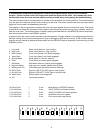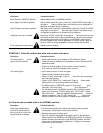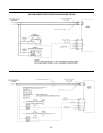
14
TROUBLESHOOTING (cont’d)
SYMPTOM 8. Water will not stay in bowl and system loses vacuum.
Condition/Procedure
Put Mode Switch in “Service”
position:
Worn or damaged ush valve ball
and seal:
Corrective Action
• Clean underside of ush valve ball seal of dirt and debris.
• Remove toilet from oor and remove base assembly from toilet and
replace ush valve ball and seals.
SYMPTOM 9. Water will not shut off and overows the toilet.
Procedure
Check the “WATER VALVE” status
light:
Corrective Action
• If the light is on when not ushing the toilet or adding water, replace
the control module. If the light responds correctly, go to next step.
• Dirt or debris lodged in the water valve seal. Remove the toilet from
the oor, disassamble and clean water valve.
• Replace water valve.
SYMPTOM 10. Water is leaking from under the toilet.
Procedure
Remove the toilet from the
oor and inspect the following
with both water and electrical
power applied:
(place a container under the base
assembly to catch any water during
the inspection procedure)
• Water hoses and ttings, water valve assembly
• China toilet bowl
• Upper base seal
• Flush valve ball rotor shaft shaft
• Base assembly
SYMPTOM 11. System leaks vacuum, but water remains in toilet bowl.
Procedure
Remove the toilet from the oor
and insert a plug or vacuum tester
into the discharge port of the oor
ange or discharge adapter:
Corrective Action
• If the vacuum leaks stops, go to the next step. If the vacuum leak
continues, the leak is in the discharge plumbing and not the toilet.
• Inspect the O-ring around the bottom of the base. Replace if defec-
tive.
• Inspect the inside surface of the discharge adapter or oor ange for
grooves or scratches that may interfere with the O-ring seal. Replace
if defective.
• If all of above appear normal, then the leak is most likely the rotor
shaft O-rings. Replace the rotor shaft.


















